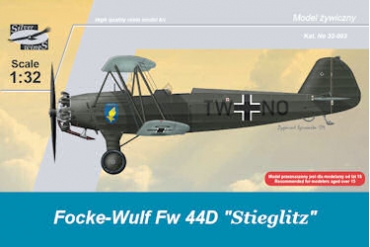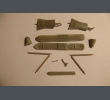Focke-Wulf Fw44D wheeled - ski
-
 Box - Luftwaffe wheeled version
Box - Luftwaffe wheeled version
-
 Box - Luftwaffe ski version
Box - Luftwaffe ski version
History
Focke-Wulf Fw 44 Stieglitz was one of the most successful pre-war Luftwaffe trainer aircraft. It was produced as a two-seat biplane of classic construction, powered by a Siemens Sh 14a 7-cylinder radial engine. The prototype first flew in August 1932. A second version of the Fw 44 was the Fw 44B, which had an Argus As 8 four-cylinder inverted inline air-cooled engine of 120 hp (90 kW). Over 1700 Fw 44 was built in following variants : Fw 44 A - pre-production series of machines used mostly for aerobatics, Fw 44B - small initial production series powered by the Argus As 8 inline engine, Fw 44C - main production variant, with smaller changes in the equipment, powered by Siemens Sh.14A,, Fw 44D - a small upgrade of the “C” model, featuring the exhaust collector and a luggage compartment placed behind the rear cockpit, Fw 44E - basically identical with the “C” model, this version had a luggage compartment adapted from the “D”, Fw 44F - an upgrade of the Fw 44D with addition of the tail wheel in place of the skid featured by the earlier models, Fw 44J - export version also driven by the Sh.14A and based on Fw 44D. In Luftwaffe, the Stieglitz soldiered until the end of the World War II - mainly as trainer aircraft in the many Flugzeugführerschulen. Fw 44 was also used in: Argentina, Austria, Bolivia, Brazil, Bulgaria, China, Chile, Colombia, Czechoslovakia, Finland, Hungary, Poland, Romania, Slovakia, Sweden, Turkey.
Technical data:
Length: 7,30 m
Wingspan: 9,00 m
Height: 2,80 m
Power plant: Siemens Sh 14 A-4 7-cylinder radial engine, 118 kW (160 hp)
Max speed: 185 km/h
Range: 550 km
Service ceiling: 3900 m

























